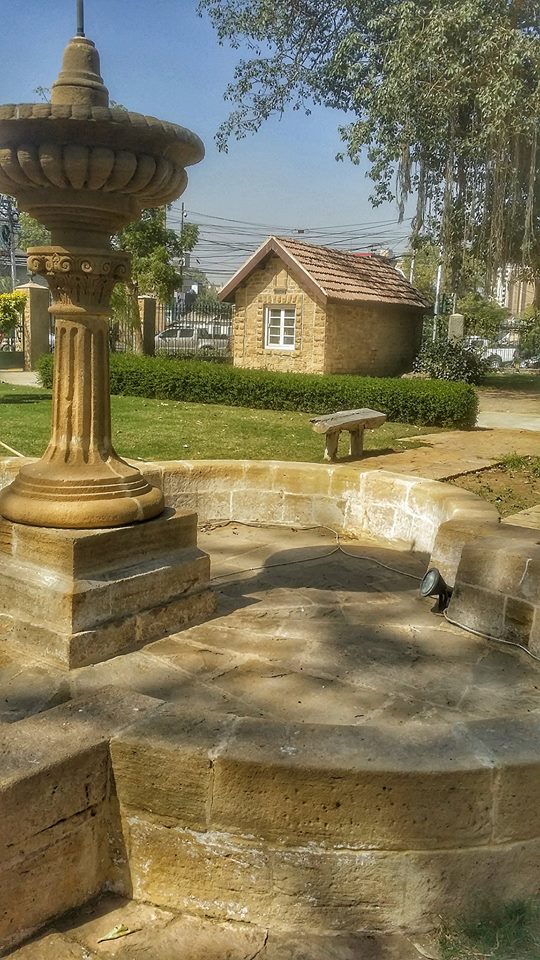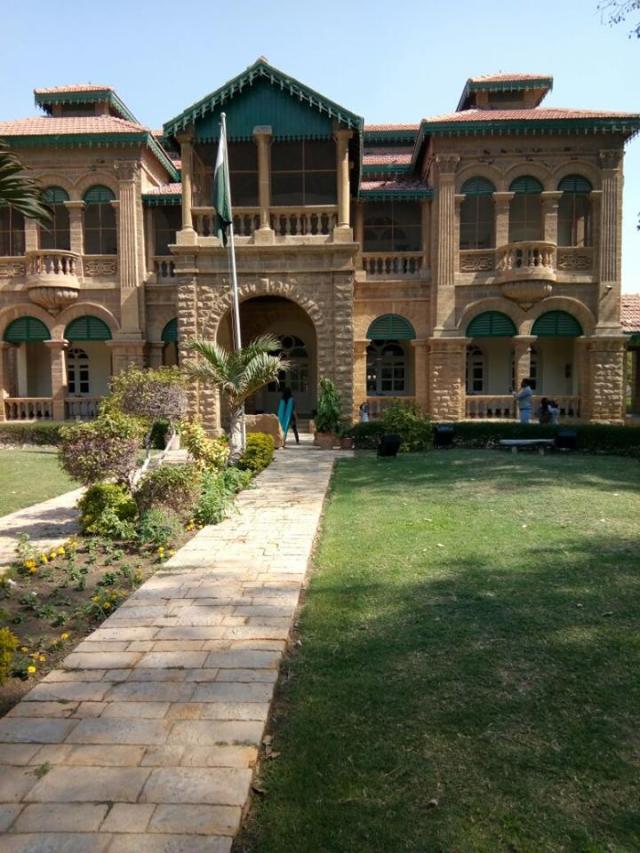Every time while crossing the Avari signal, I would look at this striking brownstone building and thought if it’s open for the public. I would think if it is, I don’t see a lot of people visiting and talking about it. This and a few other places in Karachi made me launch this new segment “Matargasht” on the blog where I look forward to reviewing the larger than life yet forgotten places of the city. This is the first review following my visit to the Quaid-e-Azam house formerly known as “Flagstaff house”.

The house was built in 1890. Jinnah purchased this house from a Parsi resident in 1943. It was originally known as flagstaff house until after the death of Fatima Jinnah. Following that, Pakistan Archaeology department bought this house and turned it into a museum, now called the Quaid-e-Azam house. Later, Hakim Muhammad Saeed-the then governor of Sind-officially inaugurated this house in 1993.
I visited the place with Abbu a few weeks back and as usual, he was way excited than I was *no surprise-he is for every new project*. We were not sure about the visiting hours or days, but we chose Saturday hoping it would be open for public. Thankfully it was and we reached the place around 11 a.m. The visitors are not allowed to take their vehicles inside the vicinity, but as the area is not crowded, you will easily find parking outside the gate. There was just one guard inside the building who took our NICs and had us enter our names on the visiting list.



We headed towards the corridor and saw, Rasheed-the caretaker and curator of Quaid-e-Azam house-moving forward to welcome us. He was happy to know that we are from Karachi, and still enthusiastic about this visit because only tourists, or school groups mostly are interested in this place. He provided us a little background of the house and walked us through the backyard.

A peep inside the living History!
A stone pavement led us to the backyard where we saw a small room opposite the back entrance. Rasheed told us this room was used as a kitchen and Jinnah wanted it to build separately from the main building. Now, this room is used as an administrative office, so we just stopped for a few pictures and walked inside the main residential building from the back door.

On entering inside, we saw a narrow hallway of Jinnah’s personal and official drawing rooms. The major highlight in this hallway is a chest of exquisite crockery gifted by China and Japan to Jinnah. The drawing room is simple yet aesthetically set with wooden furniture and two sofa sets.



Next, we headed to the living room which was also used as an office by Jinnah. Right on entering the room, we saw a map of Pakistan made of broken glasses hanging on the wall. This intricate map was created by Rafique Motiwala, a businessman from Bombay who later gifted it to Jinnah. Beside it hangs the portrait of Fatima Jinnah sketched by an artist Sarah Ikhlaq in 1963.

As you see in the Picture below, Jinnah’s work desk is quite minimalist, yet gives a really refined and polished look. A shiny, metallic telephone set stands by the work desk, a wooden paper case, and a beautifully carved wooden basket add to space.

Moving on, Rasheed led us to a wooden staircase that goes up to the personal rooms of Quaid-e-Azam, and Fatima Jinnah. The staircase displays an old family photo of Jinnah, and a note by Dina Wadia (Jinnah’s daughter) who visited the house in 2004.

Jinnah’s room features a collection of clothes, shoes, and books. His bedroom speaks simplicity as only the necessary items are kept. A jute lamp and a telephone by his bedside, a sofa set, and a document chest are placed inside the room. A copy of Holy Quran wrapped in a silver case is also placed on the wooden book holder. Aligarh Muslim league gifted this copy of Quran to Jinnah.


Fatima Jinnah’s bedroom is equally minimalist and graceful. The water jug and glass which was in her use is still kept on the bedside table, a pair of slippers sit on the carpet as if ready to be worn, a glass door closet stands tall on the other side, and a wooden chair set graces the entrance of the room. Next to the bedroom is her dressing area featuring an exotic wooden dressing table, a small cupboard, and a beautiful wooden Victorian room divider. Simplicity and elegance are that I can discern from her room!


A small dining hall separates Quaid-e-Azam’s and Fatima Jinnah’s rooms. The hall is graced by Kashmiri wooden carved furniture. The intricacy of this design is absolutely marvelous! Rasheed took us to the balcony on the first floor and told us how this area was peaceful and quite during that time and one could easily hear sea roaring from far away.


The place had us witness the simple lifestyle of a personality as magnanimous as Jinnah! He was a man of great taste and had an eye for all the finer things in life, so undoubtedly this house showcases a piece of his personality!
I left this place with a pinch of inspiration and awe in my heart.
A little about Rasheed-The curator
Rasheed served Muhammad Ali Jinnah and Fatima Jinnah and closely witnessed their inspiring lives. His patriotism and love for the Quaid were apparent throughout the tour and I was surprised to see how enthusiastically he narrated the event associated with every precious item inside the house!
He complained how no one really visits this place except schools and colleges once in a while. He was also quite upset how we are getting away from the real spirit of Pakistan. Though he is still hopeful about the potential and good intentions the present generation has towards the country!
Initially, Rasheed didn’t allow me to take pictures inside the house and I didn’t understand why, but when I told him these pictures and post will encourage people to visit the place, he was quite lenient about it. I hope this post serves its purpose, and you visit this place at least once!
Visiting Days and Hours!
You can visit the house every day from 9 a.m to 4. p.m except on Wednesdays.
I’ll see you soon with another amazing, not necessarily historic place! Until next time!
- Are Google Certificates Worth Your Career Investment? - May 5, 2024
- How to Find and Fix Broken Links: A Comprehensive Guide - April 26, 2024
- Dynamic Pricing Strategies: Using AI to Optimize Pricing in E-commerce - April 9, 2024











